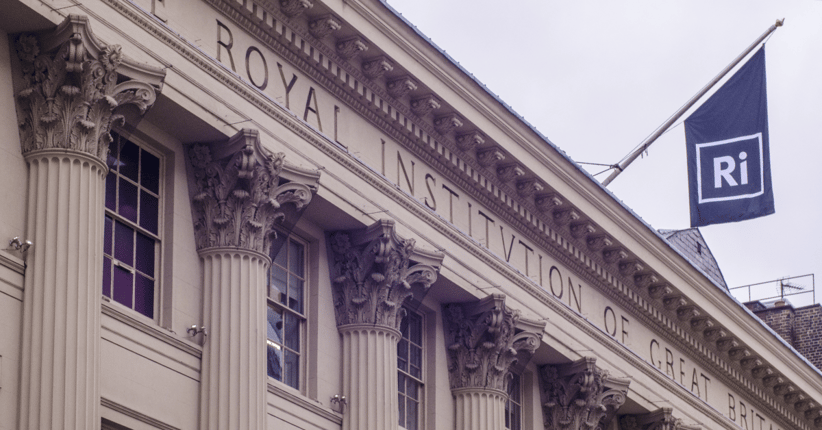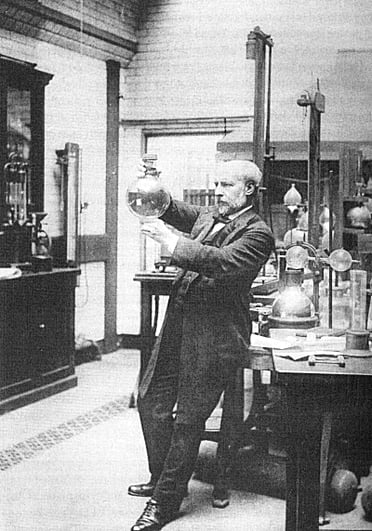With 1.4 million subscribers on YouTube, the organisation is finding new ways to enthuse the younger generation about science, director Katherine Mathieson tells Mewburn Ellis.
Forward: features are independent pieces written for Mewburn Ellis discussing and celebrating the best of innovation and exploration from the scientific and entrepreneurial worlds.
In between the high-end restaurants and luxury stores of Albemarle Street in Mayfair, there is one building that stands out in its architecture, its purpose – and its sense of permanence. Graced by a colonnade of Corinthian columns, the Royal Institution is the place where ten chemical elements were first discovered or isolated by scientists, including sodium and calcium, and where in 1821, Michael Faraday invented the first electric motor. Today, it is a place where the public and scientists explore science together and where Britain’s next generation of scientists is born.
Founded in 1799, the Royal Institution has pioneered everything from electrochemistry to lighthouse technology. What makes it even more unusual is that it has always focused on being an innovator in science communication, bringing insights from the laboratory to the stage. The charitable organisation is best known for hosting its Christmas Lectures, a series of engaging talks with eminent speakers like Carl Sagan, Sue Black, Hannah Fry, and David Attenborough.
The lecture series was originally set up by Faraday, a self-taught scientist from a humble background. In a black and white lithograph from 1856, Faraday is shown delivering a one of his Christmas lectures from 1855, and I notice that at least one third of the audience is made up of women and children. What’s also striking is that a range of glasses, vials and other implements are arranged on a large table in front of him, very much like in the presentations that are held in front of audiences of adults and young people in this grand building today.
“It is grand, but it should feel like home,” says Katherine Mathieson, the charismatic director of the Royal Institution. The organisation endeavours to open its doors to anybody who wants to learn about science. Originally a row of three Georgian townhouses that were linked and updated, the building continues to feel like a home as we walk through its interconnected rooms.
“The demonstrations are really important to us, because they have always been part of it,” says Mathieson. When the Royal Institution was founded, Mathieson notes, “They built the Theatre before the laboratories.” We walk into that same famous lecture theatre, which has mauve seats that can accommodate about 400 people. Standing in front of an imagined audience, one doesn’t even need a microphone, and there’s no need to speak up, the room has been constructed in a way to provide natural voice amplification.

The Royal Institution, graced by a colonnade of Corinthian columns
“We have an in-house demo team, who work with our speakers to develop demos and who have the skills and access to materials these speakers wouldn’t have in their regular workplace,” she says. I’m reminded of the Christmas Lecture series by Mark Miodownik, who presented a live gecko, to explain how the hair-like structures on its toes provide a large enough surface area for it to stick to a glass wall.
In addition to running programmes for schools, young people, and adults, the Royal Institution offers a family membership. Mathieson says it appeals to families, “who have a strong tradition of enjoying science, or of using science as a springboard into a career”. She adds, “A lot of people who have come to us work in the city, maybe they're patent lawyers, or engineers, professionals with a technical background. But their first love was science. How does the universe work? And so, they rediscover that affinity in the theatre, maybe with their kids.”
We go downstairs to one of the laboratories, where preparations for a workshop on bath bombs are in full swing. It will be led by an educator called Rachel, who’s wearing sparkly shoes. “We get kids as young as seven,” says Mathieson. “They are going to have great fun. And you can see we’re using scientific apparatus; they'll be learning about acids and alkalis.”
Inspiring children with the wonders of science needs to happen at a young age. Indeed, researchers at King’s College argue that aspirations for careers in STEM subjects are shaped at primary school. In their Aspires report, they found that a child, who does not aspire to science at age 10, is highly unlikely to develop science aspiration by the age of 14. This means science has to be made accessible early on.
Mathieson says, “We've had a lot of feedback from the primary school kids. ‘We love the bath bombs. We love your sparkly shoes.’ This sounds frivolous, but it's really important to get young people to feel like ‘I could be Rachel.’ And it challenges those pervasive stereotypes ‘You've got to be like, Brian Cox!’ He’s a great scientist, but sometimes you’re more of a sparkly-shoes-girl.”
When science is made more accessible – and more entertaining – it can inspire the next generation. As one Royal Institution volunteer, who’s doing a Master's degree in science at UCL, told Mathieson, “The first time I realised I loved science was in this room, in this building, age nine, when I came to a Saturday morning master class.”
The building also houses a permanent collection and temporary exhibitions, including some of the earliest known samples of elements. There is a glass tube created by John Tyndall to demonstrate why the sky is blue. There’s the miner’s safety lamp designed by Humphry Davy, its enclosed flame meant that the lamp could not heat enough flammable gas to cause an explosion, saving lives in mining shafts. “For us, science has always been about solving problems,” says Mathieson.
Another glass display on our tour contains Davy’s notebooks. “A lot of his contemporaries wouldn't have seen a hard line between science and the arts. They were exploring the world, they were curious about things,” says Mathieson. Davy’s notebooks, which focus on science, also have poetry written in their corners which Davy used to not only bring science to life but also, importantly, make it more accessible to a wider audience.
One object on display tells a tale of the importance of intellectual property protection. In the late 19th century, Sir James Dewar worked on cryogenics, the science of extreme cold, and he was looking for a way to liquefy gases.. For this purpose, he engineered a double-walled, silver-coated glass flask in 1892. Removing the air between the two glass walls created a vacuum where heat could no longer transfer. Using this vacuum flask method, he became the first person to liquefy hydrogen, the coldest substance ever produced up to that moment.

James Dewar in the Royal Institution in London, around 1900
Dewar’s glass blower, Reinhold Burger, recognised the flask’s potential as a household item. Together with a business partner, he created a domestic version of the vacuum flask which added a protective jacket to the glass flask. This product was then launched as an item we all know today: the Thermos flask. More crucially, they secured a patent for it – something Dewar had neglected to do – recognising the important step of protecting their developments in bringing the original concept to market.
At the end of our tour, Mathieson invites me along to the downstairs café for a cup of tea. “We launched a new strategy,” she says. “We want to partner with scientific organisations because we've got an insatiable appetite for great scientists. We've got a stage; we've got people who come to the stage multiple times a week.” Added to that, the Royal Institution reaches audiences far beyond its stage. They have 1.4 million subscribers on YouTube and they reach new audiences, including young women, through their channel on TikTok. “The most common format by far on YouTube is an hour-long science talk by a practising researcher,” says Mathieson, attesting to the in-depth engagement with science the organisation inspires. “That is why we’re constantly fundraising,” Mathieson continues, “to be able to have that impact, that in-depth engagement with science, in as many places as possible.”
At this year’s Christmas Lectures, the computer scientist Professor Mike Wooldridge is going to tackle the most pressing development in the world of science today: artificial intelligence. In anticipation of the lectures, the Royal Institution has hosted a Youth Summit for students aged 16-18, gathering their opinions and concerns on the topic. “How could AI help us build a better world and not make humans be any dumber?” one student asked. “What does it mean to ethically use artificial intelligence?” asked another student. “How is society protected from the dangers of AI on our mental health?” and “Is the increasing use of artificial intelligence killing creativity in society?” All of these are great questions from a young audience of potential future scientists.
The Royal Institution is steeped in history. Katherine Mathieson is making sure this is a foundation for inspiring the next generation of scientists. YouTube, TikTok, and Youth Summits are at the heart of her vision to shape future Faradays and Dewars. This may be one of the oldest organisations in the scientific world, but she is determined it will always be for the past, present and future of science.
Inspiring new generations of scientists to keep driving society forward
Joseph Newcombe, Associate and Patent Attorney at Mewburn Ellis, comments:
"Effective science communication is key to ensuring that good science continues to happen. Sharing new developments with peers helps to connect the dots and push the boundaries; likewise public engagement encourages excitement about the cutting edge and inspires new generations of scientists to keep driving society forward with innovation.
Since its foundation over 200 years ago, communicating science has been a central tenet of the Royal Institution and it’s fantastic to hear how that tradition remains so strong.
Moreover, the Royal Institution has shown an astute awareness of societal change, to pivot so well from in person events to televised lectures and now a significant social media presence. This forward-thinking attitude ensures that their messaging always reaches their target audience. Long may it continue."
Written by Marina Gerner
Joseph is a patent attorney working in the chemistry and materials field assisting in the drafting and prosecution of UK and European patents. He also has experience in opposition and appeal proceedings before the EPO and the management of national/regional phase entry of international patent applications.
Email: joseph.newcombe@mewburn.com

-3.png)
